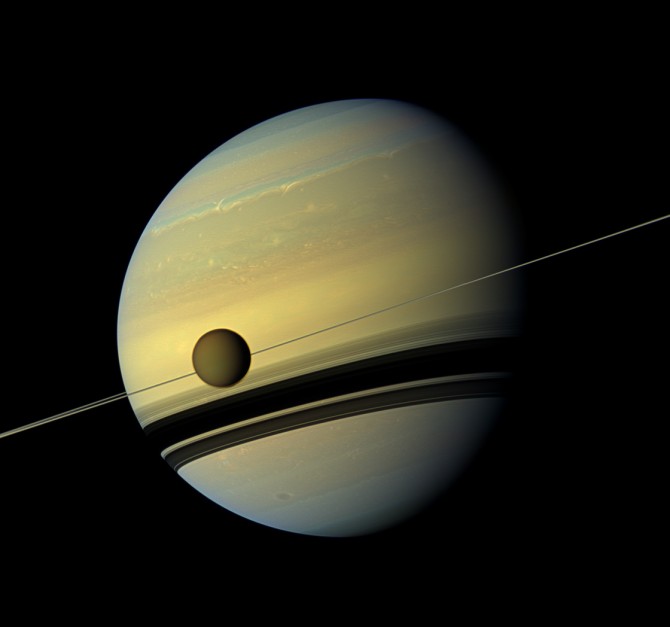Although the Cassini-Huygens spacecraft's 20-year mission to explore Saturn and its planetary system ended nearly seven years ago, it generated reams of data that are still being analyzed.
Cornell astronomers have played a major role in that analysis, and a new study of radar experiment data has yielded fresh insights related to the makeup and activity of the liquid hydrocarbon seas near the north pole of Titan, the largest of Saturn's 146 known moons.
Titan, Saturn's largest moon, crosses the rings and the planet.
The key takeaway: Using data from several bistatic radar experiments, a Cornell-led research team was able to separately analyze and estimate the composition and roughness of Titan's sea surfaces, something previous analyses of monostatic radar data were unable to achieve. This will help pave the way for future combined examinations of the nature of Titan's seas using Cassini data.
Valerio Poggiali, a research associate in the Cornell Center for Astrophysics and Planetary Science (CCAPS) in the College of Arts and Sciences (A&S), is lead author of "Surface Properties of the Seas of Titan as Revealed by Cassini Mission Bistatic Radar Experiments," which published July 16 in Nature Communications.
Co-authors include Alexander Hayes '03, M.Eng. '04, the Jennifer and Albert Sohn Professor and director of CCAPS; Philip Nicholson, a professor in the Department of Astronomy (A&S); and Daniel Lalich, a CCAPS research associate.
A bistatic radar experiment involves aiming a radio beam from the spacecraft at the target - in this case Titan - where it is reflected toward the receiving antenna on Earth. This surface reflection is polarized - meaning that it provides information collected from two independent perspectives, as opposed to the one provided by monostatic radar data, where the reflected signal returns to the spacecraft.
"The main difference," Poggiali said, "is that the bistatic information is a more complete dataset, and is sensitive to both the composition of the reflecting surface and to its roughness."
Said Nicholson: "The successful execution of a bistatic radar experiment requires exquisite choreography between the scientists who design it, Cassini mission planners and navigators, and the team who collects the data at the receiving station."
The current work used four bistatic radar observations, collected by Cassini during four flybys in 2014 - on May 17, June 18, Oct. 24 and in 2016 - on Nov. 14. For each, surface reflections were observed as the spacecraft neared its closest approach to Titan (ingress), and again as it moved away (egress). The team analyzed data from the egress observations of Titan's three large polar seas: Kraken Mare, Ligeia Mare and Punga Mare.
Their analysis found differences in the composition of the hydrocarbon seas' surface layers, dependent on latitude and location (near rivers and estuaries, for example). Specifically, the southernmost portion of Kraken Mare shows the highest dielectric constant - a measure of a material's ability to reflect a radio signal. For example, water on Earth is very reflective, with a dielectric constant of around 80; the ethane and methane seas of Titan measure around 1.7.
The researchers also determined that all three seas were mostly calm at the time of the flybys, with surface waves no larger than 3.3 millimeters. A slightly higher level of roughness - up to 5.2 mm - was detected near coastal areas, estuaries and interbasin straits, possible indications of tidal currents.
"We also have indications that the rivers feeding the seas are pure methane," Poggiali said, "until they flow into the open liquid seas, which are more ethane-rich. It's like on Earth, when fresh-water rivers flow into and mix with the salty water of the oceans."
"This fits nicely with meteorological models for Titan," Nicholson said, "which predict that the 'rain' that falls from its skies is likely to be almost pure methane, but with trace amounts of ethane and other hydrocarbons."
Poggiali said more work is already underway on the data Cassini generated during its 13-year examination of Titan. "There is a mine of data that still waits to be fully analyzed in ways that should yield more discoveries," he said. "This is only the first step."
Other contributors to this work are from the Università di Bologna; the Observatoire de Paris; NASA's Jet Propulsion Laboratory (JPL); the California Institute of Technology; and the Massachusetts Institute of Technology.
Support for this research came from NASA and from the Italian Space Agency.







